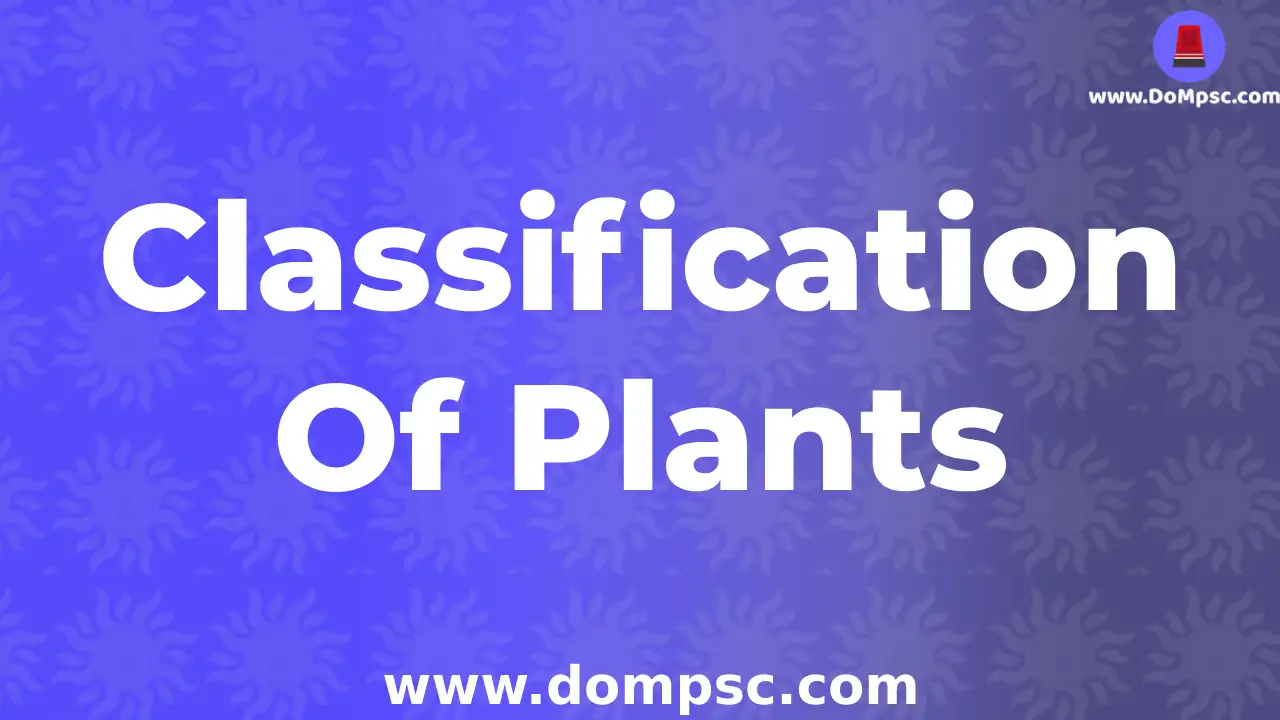MPSC Classification of Plants(वनस्पतींचे वर्गीकरण)-MPSC Biology science notes

✪ Download pdf Works Properly on chrome Browser ✪
Classification of Plants(वनस्पतींचे वर्गीकरण)
Table Of Contain-Mpsc Classification of Plants
Intro-Classification of Plants

By Shubham Vyawahare
0-May-2025
➤ Scientist Related to plant classification.
➤ Pedanius Dioscorides.
➤ Andrea Cesalpino -by Fruits and Seeds.
➤ John Ray.
➤ Carl Linnaeus.
➤ Michel Adanson.
➤ Augustin Pyramus de Candolle.
➤ Eichler system-Divided By Reproductive Organs Systems
✪ Eicher Divided Plant in a Cryptogmae And Phanerogamae
✪ Cryptogmae (अबीजपत्री) ✪
➤ In Greek words KRYPTOS means hidden and GAMOS which means marriage,Means asexual reproduction.
➤ This is a type of plants that doesn't have flowers or seeds.
➤ Their reproductive systems work with spores.
➤ These reproduce vegetatively, asexually and sexually.
➤ Sexual reproduction takes place by fusion of male and female gametes.
➤ R.H whittaker Further divided cryptogmae in 3 parts.
✪ Thalophyta-Algae ✪
➤The main component Found In this type are Algae.
➤These include algae, fungi, bacteria, and lichens.
➤Plants where the body is not differentiated into roots, leaves, and stems.
➤ roots, leaves, and stems Not Found.
➤ These are aquatic plants that can grow in fresh as well as marine water.
➤ These lack vascular system.
➤ 90% of photosynthesis done by Algae in the world.
➤ Algae Wall is made up of pectin and cellulose.
➤ Phycology Is the Study branch of ALgae.
➤ William Henry Harvey is the father of Phycology.
➤ .O.P. lyenger from Madras University is known as the 'father of Modern Algology of India
✪ ThaloPhyta Further Divided in three parts
1.Green Algae-Chlorophyceae
➤Generally found in Fresh Water.
➤ Examples-Ulothrix,Fucus,Porphyra,Spirogyra.
➤ Parts of the mouth include the lips, vestibule, mouth cavity, gums, teeth.
2.Brown Algae-Phaeophyceae
➤Chlorophyll-B Not present.
➤ It contain Algine with cellulose in cellWall.
➤ Examples-Ectocarpus,Tilopetris,Cutleria,sporochnus.
3. Red Algae-RhodoPhyceae
➤ Found in marine water.
➤ Cellulose and pectin present in cell wall
➤Algae's red color due phycoerythrin present in a body. ➤ Examples-Chondrus Mastocarpus.
➤ generally found in damp and moist places.
✪ Bryophyta ✪
➤ These include liverworts, horned liverworts, and mosses.
➤no vascular tissues.
➤Roots Not found but rhizoids work as root.
➤ These can grow both on land and in water.
➤Bryology is the branch of botany concerned with the scientific study of bryophytes.
➤Johann Hedwig is the father of bryology.
➤Kashyap is the indian Bryology Father.
➤ Further divided in mosses and hornworts.
Pteridophyta
➤ Modern Vascular tissue found.
➤ It has roots,leaves,seeds.
➤ Found in all habitat (Water,land )
➤ asexual(by spore) and sexual(gametes) reproduction happens.
➤ Division by Spore are - Micro spore and MAcrospore.
➤ Further divided into 4 parts.
✪ Psilopphyta-plants that have large, dissected leaves, and sporangia that are borne on the leaves
✪ Lycohyta-he modern plants are kidney-shaped, like those of the ancestral forms, and borne on sporophylls clustered in strobili.
✪ Arthophyta-plants ranging in size from a few millimeters (duckweeds) to a hundred meters (trees).
✪ Filicophyta-They are homosporous ferns. They produce usually heart-shaped prothalli (gametophytes) which bear sex organs (antheridia and archegonia) on their ventral surface
✪ Phanerogamae (बीजपत्री) ✪
➤ Phanerogams are plants that have special structures for reproduction and generate seeds.
➤Phanerogams are classified depending on the presence or absence of fruits.
➤ the plant body is divided into distinct root, shoot, and leaves.
➤These are multicellular, eukaryotic and chlorophyll containing plants..
➤ These are photoautotrophic and produce own food by photosynthesis.
➤Divided into 2 types
✪ Gymnosperms ✪
➤They do not have an outer covering or shell around their seeds..
➤ They do not produce flowers.
➤ They do not produce fruits.
➤ They are pollinated by the wind.
➤ Seeds are not formed inside a fruit.
➤They are not differentiated into ovary, style and stigma..
➤ Evergreen Life cycle
➤unisexual Reprodctions
➤Gymnosperm means naked seed.
➤The root system present in the gymnosperms is the taproot system
➤Examples-pine, spruce and fir.
✪ Angiosperms ✪
➤Seed-producing flowering plants whose seeds are enclosed within an ovary..
➤ LifeCycle is Seasonal.
➤ Reproductive system Present in flowers; can be unisexual or bisexual.
➤Further divided in MonoCotyledonous and Dicotyledonous.
➤Examples-lilies, orchids, agaves grasses ,roses, peas, sunflowers, oaks. .
Others Blogs Related to MPSC Biology Notes
➤Biology Exam Pattern
➤Blood Circulation System
➤Blood Groups And Its Diseases
➤Balanced Diet And Nutrients
➤Classification Of Animals
➤Classification OF Plants
➤Cell
➤Tissue
➤Coordination In Human
➤Digestive System
➤Diseases And Disease Types
➤Excretory System
➤Respiratory System
➤Reproductive System
➤Skeletal System
Read All MPSC blogs
- ➤केंद्र सरकारने खाजगी क्लासेस साठी नवी नियमावली लागू केली आहे |GUIDELINES FOR REGULATION OF COACHING CENTER in marathi
- ➤MPSC Data leak: पेपर न फुटल्याचा दावा MPSC आयोगाने स्पष्टपणे केला आहे
- ➤MPSC hall ticket data leaked before 6 days of exam
- ➤MPSC Data leak: टेलेग्राम वर अचानक ९० हजार परीक्षार्थींचे प्रवेशपत्र झाले लिक
- ➤मराठी भाषेला अभिजात दर्जा मिळायला हवाच , अभिजात दर्जा नेमका कसा मिळतो ?
MPSC Books pdf



